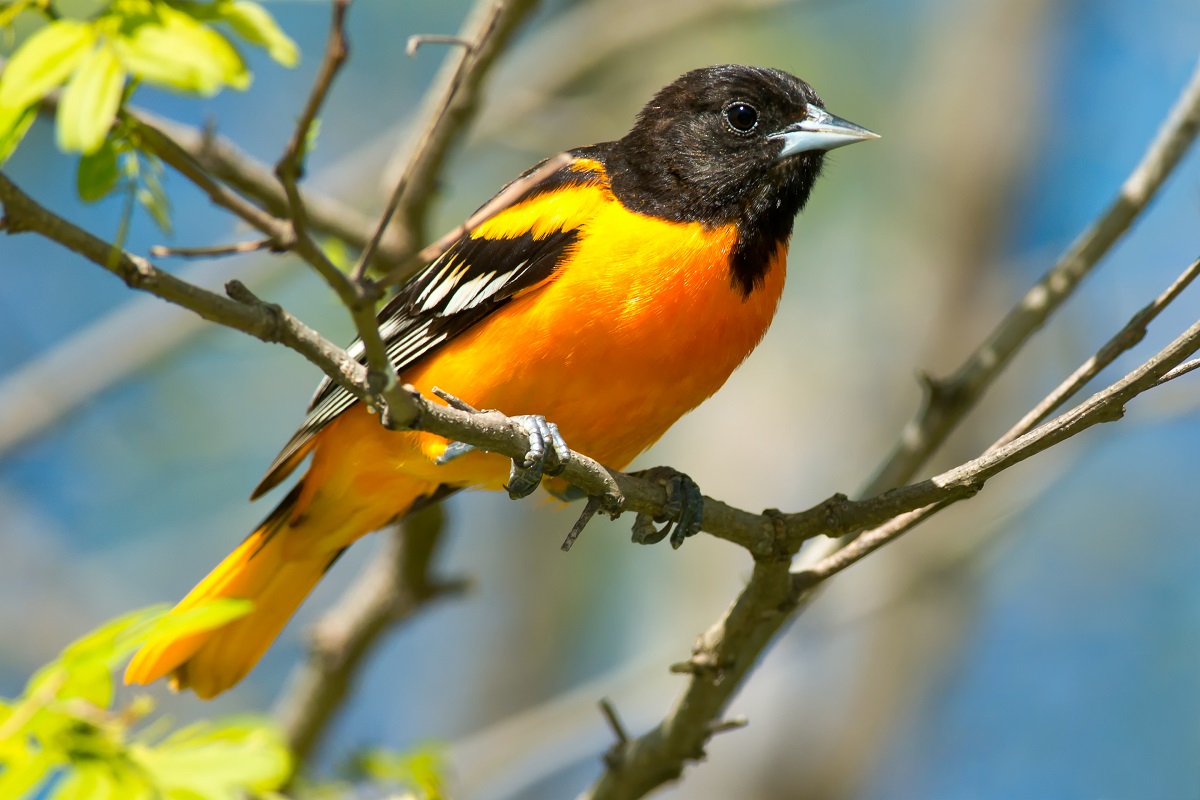Orioles are songbirds in the Blackbird family and are recognized for their bright orange and yellow colors. Oriole's songs are a mixture of melodious sounds and harsh notes. Oriole calls, mainly used to signal danger, are shorter and more aggressive. Baltimore orioles are the state bird of Maryland.
The oriole (Icterus galbula) is a small icterid blackbird named by early settlers to the US for its resemblance to the unrelated Oriolus genus of birds found in Europe. It was christened the Baltimore oriole for the similarity of its coloring to the coat-of-arms of 17th century Lord Baltimore. Baltimore orioles are noted for their beautiful sound, unique nests, and striking colors.
All orioles make similar bird sounds with slight variations depending on the species. Their bird songs can resemble flutes, though some vocalizations can sound quite harsh. Oriole songs can often be confused with American Robin songs, though the Robin sings more melodically and sounds less harsh than the oriole.
The Baltimore oriole (Icterus galbula) is so common in most of the central and eastern US that it is the state bird of Maryland and the mascot and namesake of the Baltimore Orioles baseball team. However, there many orioles in the Western Hemisphere.
Types Of Orioles In North America
Over 30 types of orioles can be found in Mexico and South America. North America has at least 9 species of orioles that are common north of the Texas-Mexico Border.
Watch our video and learn 7 things about orioles you may not have known about!
These include:
- Altamira oriole—permanent residents in the Rio Grande Valley of Texas
- Audubon’s oriole—permanent residents in the woodlands of southern Texas
- Baltimore oriole (Icterus galbula) — common in most of the central and eastern US
- Bullock’s oriole—found in western North America
- Hooded oriole—found in parts of California, Nevada, Arizona, Texas, and Mexico
- Orchard oriole—ranges from eastern North America to Mexico and South America
- Scott’s oriole—found in the southwestern US, Mexico, and South America
- Spot-breasted oriole—found in southern Mexico and Central America, and was introduced in Florida in the 1940s
- Streak-backed oriole—lives mainly in Mexico and Costa Rica, but is also found in the southwestern US
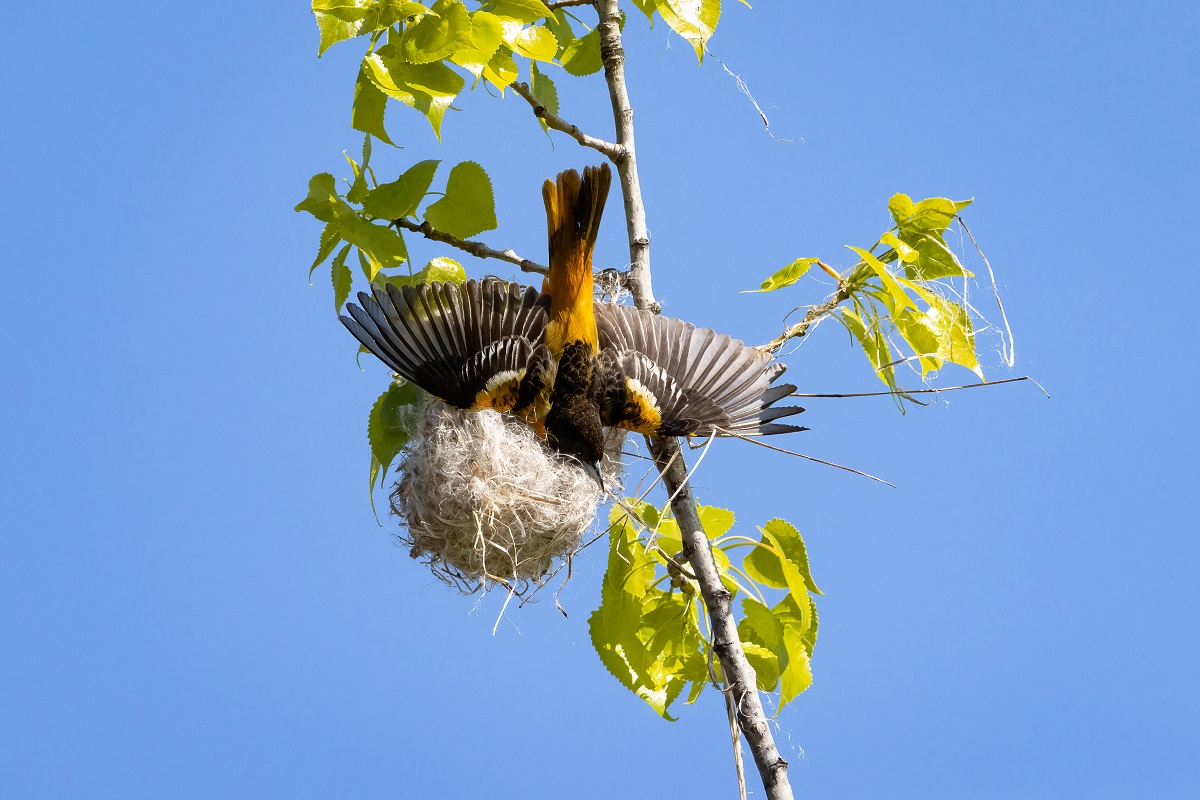
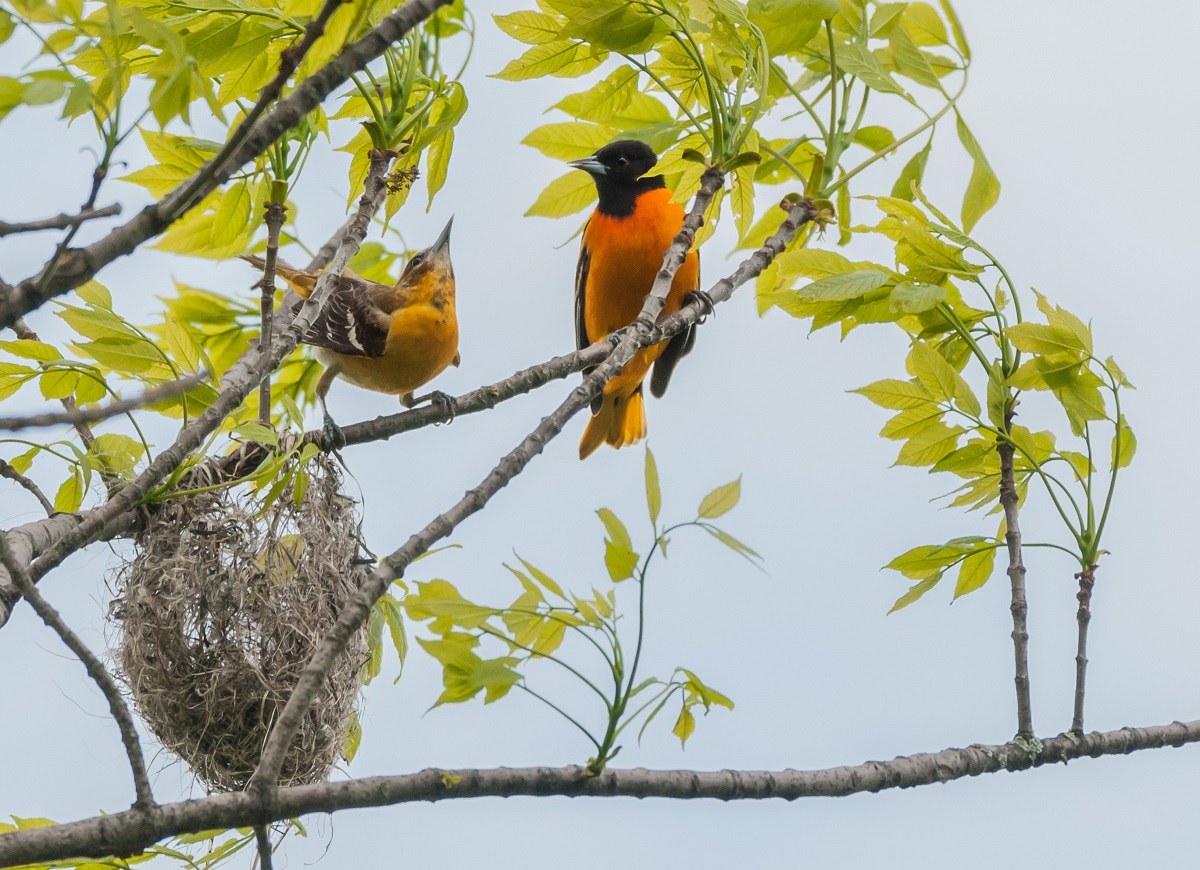
Baltimore Oriole Sounds To Listen For
The Baltimore oriole song is made of loud, clear, high-pitched notes. Their song sounds like ‘chee bee’, repeated 2-7 times per second. After each song, they pause before singing again. Baltimore oriole sounds signal springtime in the eastern US.
Male Baltimore orioles sing more than females. They sing to defend territory and also to attract a mate. In this case, the male sings from a high tree branch so his song carries to nearby females. Though male birds sing all year long, they sing 75 percent of the time during the breeding season. At other times of the year, their song is abbreviated.
In flight, males may beat their wings loudly and communicate with other males ins a flutter-drum sound.
Females busy themselves weaving their nests that swing from tree branches. They sing short songs to communicate with their mates and may occasionally sing a duet with him.
Song of Other Species of Orioles
Every species of oriole has a slightly different sound.
- Altamira orioles sing in a series of rising and falling whistles mixed with harsh chattering.
- Audubon’s orioles sing a song of slow whistles, almost sounding like a slide whistle.
- Bullock’s oriole sounds are a mix of whistled notes and rattles. They include some gruff, scratchy tones.
- Hooded oriole sounds are scratchy and mixed with chatters. They sound less sweet than other orioles.
- Orchard orioles sing in loud, clear whistles with interspersed harsh notes.
- Scott’s oriole sounds are harsh and nasal. They say ‘chuck’ or ‘wheet.’
- Spot-breasted orioles sing slow whistles that are rich and clear.
- Streak-backed oriole sounds are softer and not as melodious as other orioles. Calls sound like ‘wheet.’ Females may sing more frequently than males.
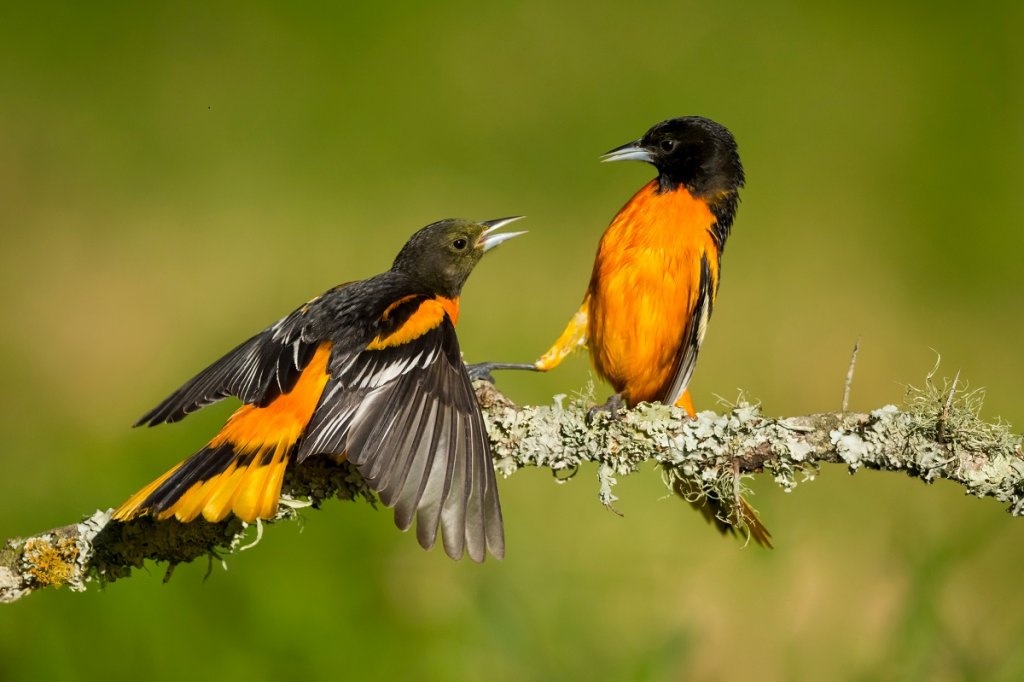
What Does Oriole Chatter Mean?
Orioles chatter for many different reasons. Most oriole chatter calls are a series of 2-30 repetitions of the same sounds:
- Alarm: their alarm call resembles a ‘chuck’ which sends a distress signal to other orioles. They continue calling until another bird comes to help,
- Defense: If they feel their territory is under attack they make aggressive, short calls,
- Defending Their Nest: Females produce a loud scream to ward off any predator,
- Begging Call: The first sound produced by fledglings, consisting of 2 sharp notes,
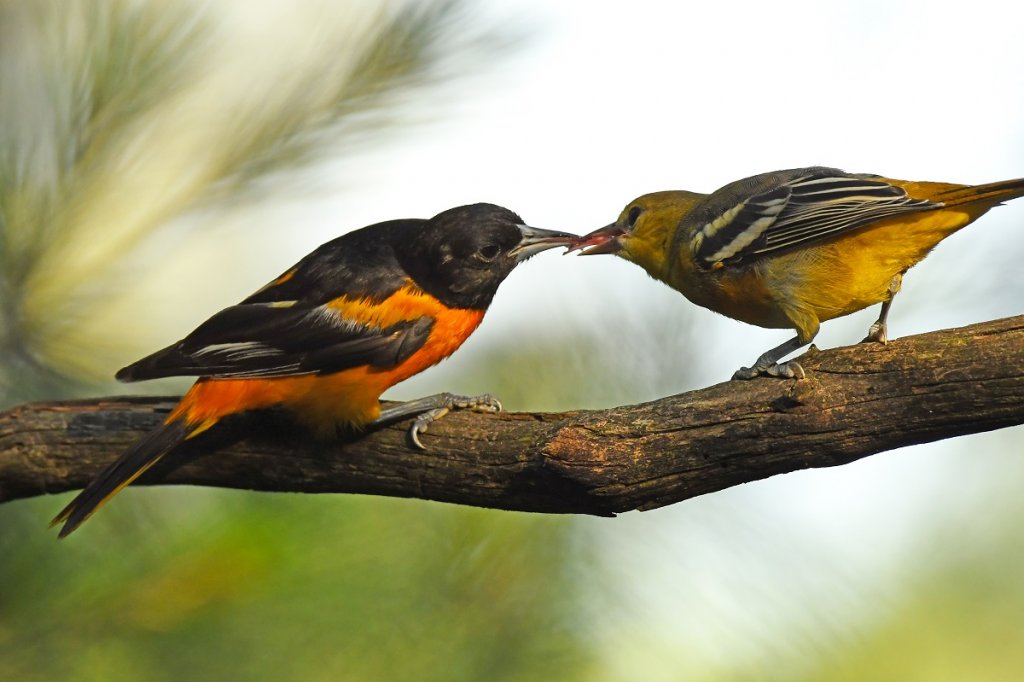
What Color Is An Oriole?
Orioles come in a variety of bright colors. Some males are burnt orange while others are yellow. Females tend to be green, gray, or dull orange. Each variety of orioles has slightly different coloring.
Altamira Orioles
- Males have black tails, wings, and backs and are bright orange and yellow all over
- Females are similar in color
Audubon’s Orioles
- Males are bright yellow and black
- Females are similar in color
Baltimore Orioles
- Males are bright orange and black and have white wing strips on top of black wings
- Females have yellow feathers underneath and on their heads. They have grayish-brown wings with yellow and brown coloring on their backs
Bullock’s Oriole
- Males have bright orange feathers with black and white wings. Their heads also have black and white.
- Females have yellow heads, chests, tails, and gray backs
Hooded Oriole
- Males are bright yellow or bright orange and have black backs and throats
- Females are similar in color
Orchard Orioles
- Males have black heads and backs and are red-colored underneath
- Females are greenish-yellow and have dark wings with white wingbars
Scott’s Oriole
- Males have a bright yellow underside with a black head and back
- Females are duller in color and have olive-brown backs
Spot-breasted Orioles
- Males are black and orange and have black spots on their breasts. They have white on the edges of their wings.
- Females are olive-green and have fewer black spots.
Streak-backed Oriole
- Males have a bright orange body with black and white streaks on their backs and wings
- Females vary in color—some have bright colors like males and others are duller
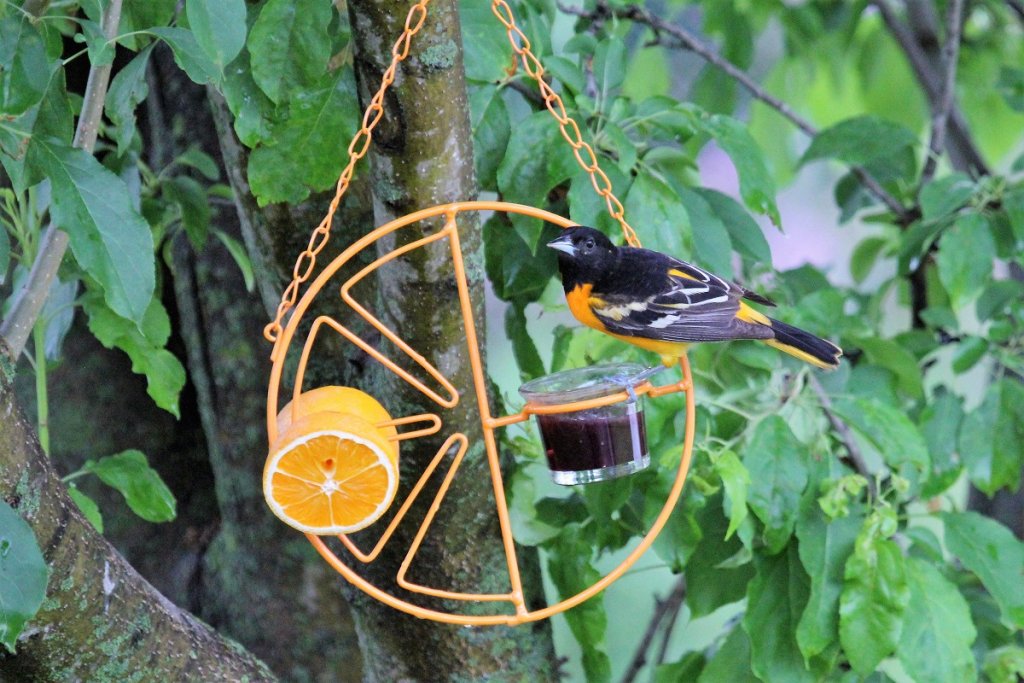
Do Orioles Like Grape Jam or Jelly?
Orioles love jams and jellies. The sugar in jams and jellies provides necessary energy and calories. For this reason, do not feed orioles any jams or jellies made with sugar substitutes. The artificial sugars may be toxic to these songbirds. orioles prefer grape kelly, but also love love orange marmalade, strawberry jam, raspberry jelly, or cherry jam—they have a big sweet tooth!
They also have a preference for dark-colored fruit, to the point they will ignore other ripe berries and do for the darkest one.
Oriole Feeders
Birdfeeders made especially for orioles accommodate the food that orioles love. If you know that orioles come to your feeders often, limit the number of sweets they can have. Doing this will ensure that they seek other food sources and have a balanced diet. orioles also eat:
- Insects and mealworms
- Flowers
- Suet
- Peas (dried, frozen, or fresh)

